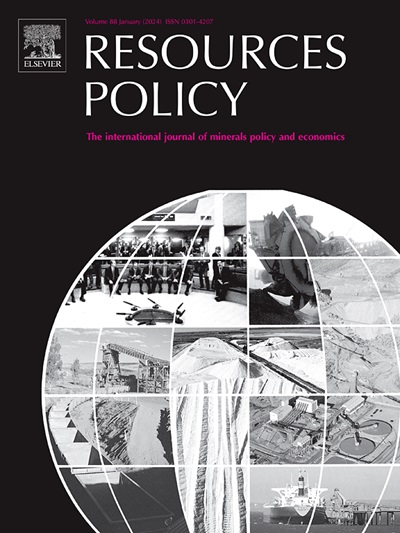Foreign direct investments and energy transition critical minerals
IF 10.2
2区 经济学
0 ENVIRONMENTAL STUDIES
引用次数: 0
Abstract
The aim of this paper is to investigate the links between energy transition critical minerals - which are crucial to the deployment of low-carbon technologies - and foreign direct investments. To this end, we consider the production of 8 energy transition critical minerals over the 1997–2020 period as an explanatory variable for FDI inflows, by using an original, complete, and precise database. Implementing a battery of panel data estimations to ensure the robustness of our results, we find that there is no FDI- resource curse for the energy transition critical minerals production. Unlike oil, energy transition critical minerals do generally attract foreign capital inflows, the positive attraction effect on resource seeker FDI likely dominates the negative eviction effect on non-resource seeker FDI; the minerals with the strongest FDI attraction effect being cobalt, lithium, and rare earth elements. These results confirm the important economic and strategic motivations of investing countries and companies, but also represent risks and opportunities for the host mining countries.
外商直接投资和能源转型的关键矿产
本文的目的是调查能源转型关键矿物(对低碳技术的部署至关重要)与外国直接投资之间的联系。为此,我们通过使用原始、完整和精确的数据库,将1997-2020年期间8种能源转型关键矿物的产量作为外国直接投资流入的解释变量。为了确保结果的稳健性,我们实施了一系列面板数据估计,发现能源转型关键矿产生产不存在FDI-资源诅咒。与石油不同,能源转型关键矿产通常确实吸引外国资本流入,对寻求资源的外国直接投资的积极吸引效应可能超过对非寻求资源的外国直接投资的消极驱逐效应;吸引外资效果最强的矿物是钴、锂和稀土元素。这些结果证实了投资国和公司的重要经济和战略动机,但也代表了东道国矿业国家的风险和机会。
本文章由计算机程序翻译,如有差异,请以英文原文为准。
求助全文
约1分钟内获得全文
求助全文
来源期刊

Resources Policy
ENVIRONMENTAL STUDIES-
CiteScore
13.40
自引率
23.50%
发文量
602
审稿时长
69 days
期刊介绍:
Resources Policy is an international journal focused on the economics and policy aspects of mineral and fossil fuel extraction, production, and utilization. It targets individuals in academia, government, and industry. The journal seeks original research submissions analyzing public policy, economics, social science, geography, and finance in the fields of mining, non-fuel minerals, energy minerals, fossil fuels, and metals. Mineral economics topics covered include mineral market analysis, price analysis, project evaluation, mining and sustainable development, mineral resource rents, resource curse, mineral wealth and corruption, mineral taxation and regulation, strategic minerals and their supply, and the impact of mineral development on local communities and indigenous populations. The journal specifically excludes papers with agriculture, forestry, or fisheries as their primary focus.
 求助内容:
求助内容: 应助结果提醒方式:
应助结果提醒方式:


